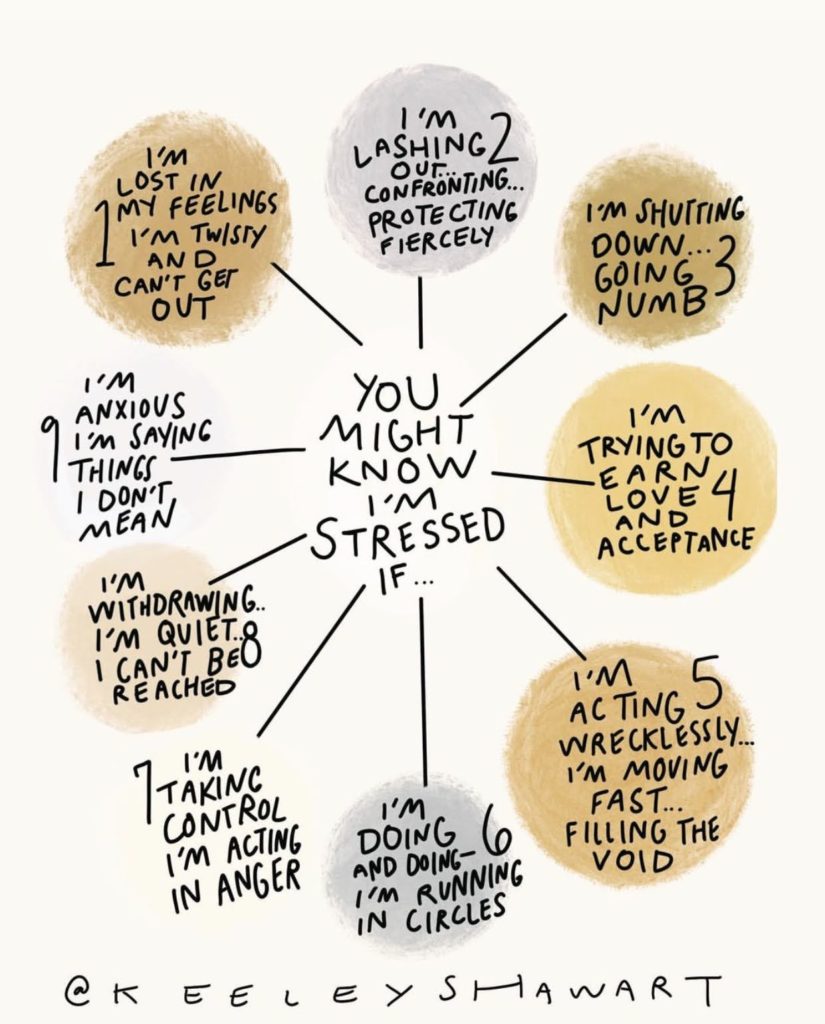This is part 4 in a series on Self-Care Strategies for Fear. You can find part 1 here, part 2 here, and part 3 here.
Tending Feelings Self-Care Strategies for Fear
As you’re spending time in your garden, you’ll notice uncomfortable emotions. This might be one reason you struggle to make time for yourself.
Emotions can be very inconvenient, downright painful, and at times excruciating.
Emotions are also called feelings, because we feel them in our bodies. Feeling things in our bodies is something that Americans in general, and white Americans 🙋 in particular, often avoid. This avoidance of feeling our feelings is at the root of many of our distraction-techniques and addictions.
How emotions relate to burnout
The first warning light that signaled my burnout was physical pain. I was unable to sleep, run, play with my kids, do yoga, or even brush my teeth without shooting, aching, burning pain in my wrist, arm, shoulder, neck, and head. I tried all the typical physical healing modalities I had access to: supplements, physical therapy, diet, chiropractic treatments, acupuncture treatments.
It wasn’t until I explored my experience of the pain with my own coach, that I began to uncover the years of emotions that were just sitting in my internal waiting room – begging to be heard. Together in that safe container of support, we made space for guilt, anger, sadness, regret, feelings of unworthiness, fear, and finally hope, joy, pleasure, and love.
Emily and Amelia Nagoski wrote a whole, amazing book on this subject. They say, “Emotions are tunnels. If you go all the way through them, you get to the light at the end. Exhaustion happens when we get stuck in an emotion.”
Let that sink in.
Exhaustion happens when we get stuck in an emotion.
Emotional exhaustion is one of the hallmarks of burnout, according to Herbert J. Freudenberger who coined his definition in 1974. Emotional exhaustion is described as, “fatigue that comes from caring too much for too long.”
Of the three components of burnout, emotional exhaustion is the one most strongly linked to negative impacts on health, our relationships, and our work – especially for women or those aligned with feminine cultural norms.
Every word of this Brene Brown podcast episode with the Nagoskis describes so beautifully how emotional exhaustion contributes to burnout and what to do about it. This is required listening or reading for every interpreter!
Burnout and How to Complete the Stress Cycle
Feelings always end

Photo by Jana Sabeth
When emotions are stored up without acknowledgment or space to be felt, they must get our attention in other ways. It can be so scary to allow these feelings to move through you. It can feel as if they’ll never leave or they’ll consume us – but I’m here to tell you:
They always end.
Just like a wave, crashing on shore, feelings have a beginning, a crescendo, and a receding conclusion. The more willing and intentional we are about giving them space and ways to move, the less backlog we incur, and the more clear, present, and grounded we can be – even through our experience of them.
This Saturday, October 24th, 2020, I’ll be teaching a specific practice for completing the stress cycle and allowing emotions to move through that you can be doing throughout your day. Check out Self-Care for Stressful Times and join us!
Lean on your boundaries
When you first begin feeling your feelings, put some supports and boundaries in place to make it feel safer. Play music that helps you access the feelings that are coming up. Try this song for sadness. This one for anger. This one for disappointment. Make a whole playlist of your own.
Keep a comfort object nearby – a pillow, soft blanket, or an essential oil. Juniper is especially helpful for fear. Set a timer, and when it goes off switch to an activity that feels comforting and safe.
Reach out to a professional – a therapist, a coach, a spiritual guide. Get support in place so that you can feel free to explore this messy, roiling mass that is our unprocessed emotions.
We’ll be talking more about ways to honor our own boundaries and to build trust with ourselves in the November Burnout Proof Saturday School workshop: Healthy Boundaries for Interpreters. Register to join us here.
Commit to staying with yourself
It can be really scary to feel some of these feelings, or you might not feel anything at all. Whatever you find here as you explore your emotions is a-okay. The most important thing is to stay with yourself. This means:
Don’t judge yourself or your experience.
Be willing to be uncomfortable.
Prioritize time and space for yourself – even if it’s just 5 minutes.
Notice that you’re still here when the feelings pass.
Allow yourself to feel proud of this scary accomplishment.
Resources for Feeling Your Feelings
- Burnout and How to Complete the Stress Cycle – Brene Brown with Emily and Amelia Nagoski
- The Dark Side of The Light Chasers: Reclaiming Your Power, Creativity, Brilliance, and Dreams – Debbie Ford
- 16-Second Stress-Relief for Sign Language Interpreters – Brighter Focus blog
- Trying to Control Your Emotions Might Be the Problem, Not the Solution – Lyra Health blog
- Get right with your darkness – Mama Gena blog
- Understanding Your Sadness – Michelle D’Avella YouTube
- The Body Keeps The Score: Brain, Mind, and Body in The Healing of Trauma – Bessel Van Der Kolk
Tiny Action for This Week
Set a timer for 5 minutes and be with your feelings. Maybe you have a certain situation you want to focus on to inspire the feelings, or maybe they’re already simmering at the surface. Just give them space and keep breathing through them.
This may be in your bedroom or bathroom, with the door locked, in your parked car, or outside while walking or running.
Let us know in the comments:
What helps you access and process your emotions?
Next Week – Pull the Weeds
In part 5 next week we’ll explore ways to identify the weeds in our thinking patterns and how to work with them when we find them. Because our thoughts feed our emotions, pulling the weeds helps to reduce how often we go through our stress cycle.
Until then, take such good care of your precious self.




Pingback: Pull the Weeds | Self-Care Strategies for Fear part 5 - Brighter Focus Self-Care CEUs
Pingback: In The Waiting - Brighter Focus Self-Care CEUs